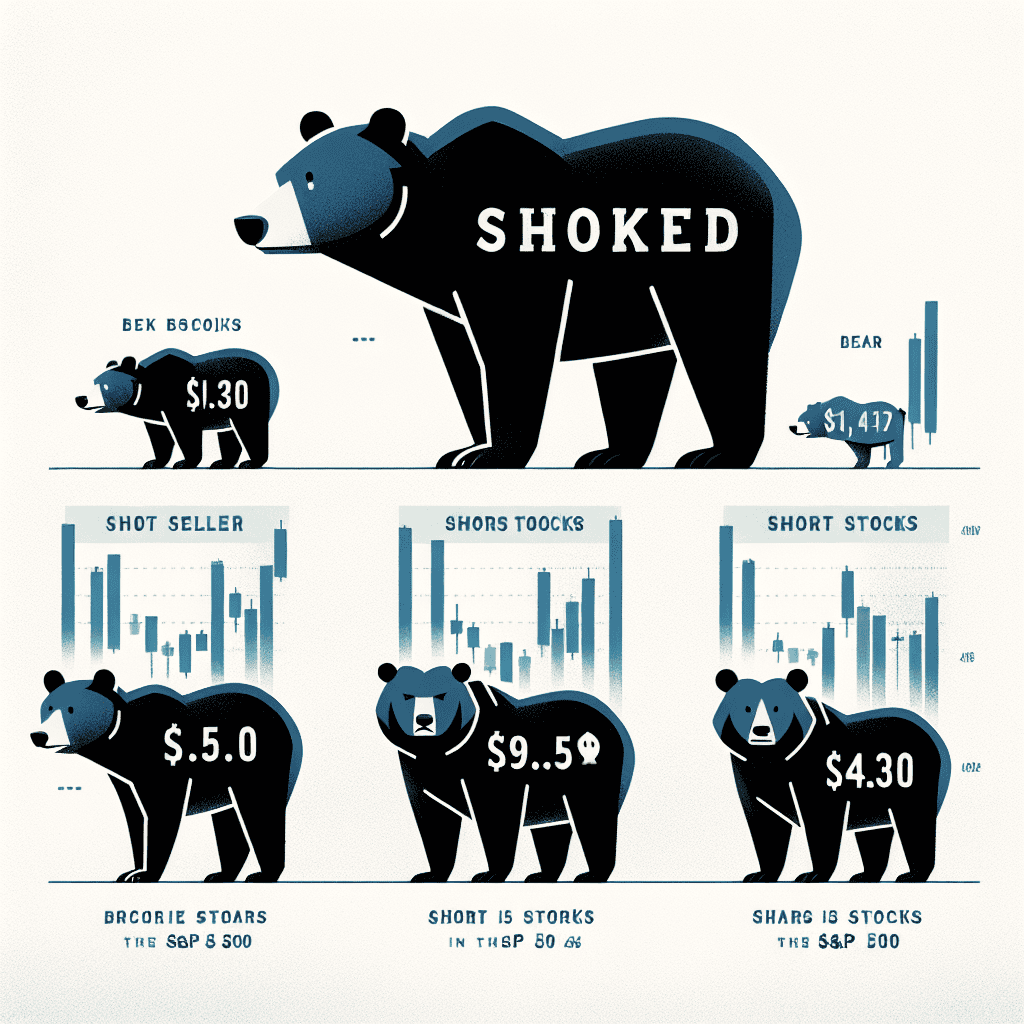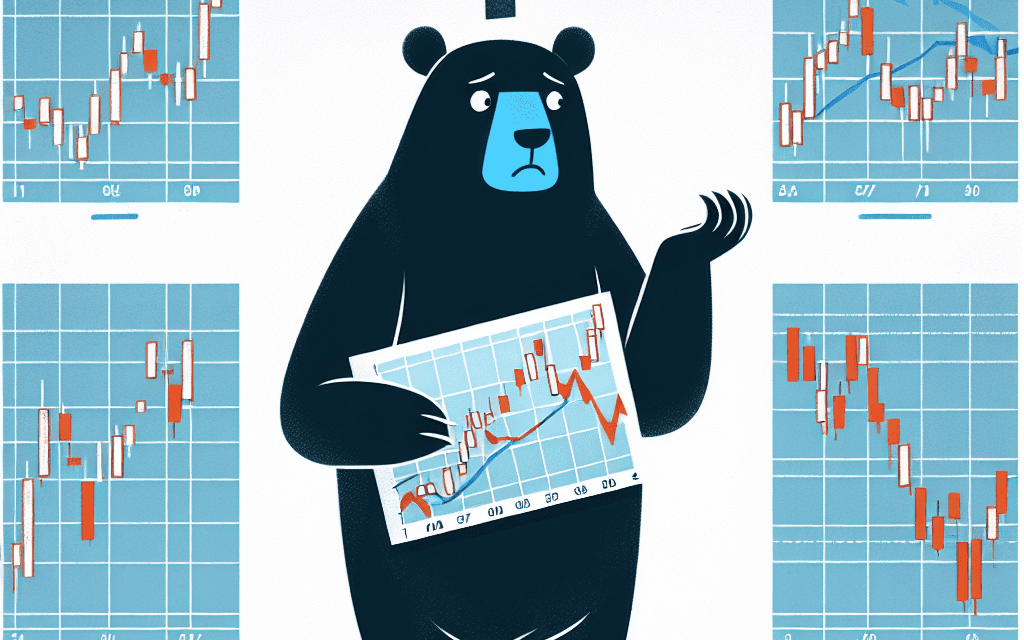“Top 5 Shorted Stocks in the S&P 500: Where Bears Miscalculate and Bulls Seize Opportunity”
Introduction
In the dynamic world of stock trading, short selling remains a popular strategy for investors betting against a company’s future performance. Within the S&P 500, a benchmark index representing 500 of the largest publicly traded companies in the U.S., certain stocks consistently attract the attention of short sellers. These stocks, often perceived as overvalued or facing significant challenges, become prime targets for those anticipating a decline in their market value. However, the volatile nature of the stock market means that short sellers sometimes misjudge, leading to unexpected outcomes. This analysis delves into the top five most shorted stocks within the S&P 500, exploring the reasons behind their high short interest and examining instances where bearish predictions have gone awry.
Understanding Short Selling: A Deep Dive into the S&P 500’s Most Shorted Stocks
Short selling is a sophisticated investment strategy that involves borrowing shares of a stock and selling them with the intention of repurchasing them at a lower price. This approach is often employed by investors who anticipate a decline in the stock’s value, allowing them to profit from the difference. Within the S&P 500, a benchmark index that includes 500 of the largest publicly traded companies in the United States, certain stocks attract significant short interest. This can be indicative of market sentiment, as well as potential volatility. Understanding the dynamics of short selling and identifying the most shorted stocks in the S&P 500 can provide valuable insights into market trends and investor behavior.
Among the top five most shorted stocks in the S&P 500, one often finds companies facing challenges such as declining revenues, regulatory scrutiny, or disruptive competition. These factors can lead investors to bet against the stock, anticipating further declines. However, it is crucial to recognize that high short interest can also lead to a phenomenon known as a “short squeeze.” This occurs when a heavily shorted stock experiences a sudden price increase, forcing short sellers to buy back shares to cover their positions, thereby driving the price even higher. Consequently, short selling carries inherent risks, and misjudging a stock’s potential can result in significant losses.
One of the most shorted stocks in the S&P 500 is often a company that has recently experienced a downturn in its core business. For instance, a traditional retail giant struggling to adapt to the e-commerce landscape may find itself under pressure from short sellers. These investors may believe that the company’s inability to compete effectively with online retailers will lead to further erosion of its market share and profitability. However, if the company successfully implements a turnaround strategy, such as enhancing its digital presence or optimizing its supply chain, the stock could defy bearish expectations.
Another frequently shorted stock might be a technology firm facing regulatory challenges. In an era where data privacy and antitrust concerns are at the forefront, tech companies can become targets for short sellers who anticipate costly legal battles or restrictive regulations. Yet, these companies often possess innovative capabilities and substantial resources, enabling them to navigate such challenges and potentially emerge stronger. Thus, while short sellers may focus on immediate hurdles, they may overlook the long-term growth prospects of these firms.
Additionally, stocks in the energy sector can attract short interest due to fluctuating commodity prices and environmental concerns. Investors may short these stocks if they predict a decline in oil prices or increased regulatory pressure on fossil fuel companies. However, energy companies that diversify their portfolios to include renewable energy sources or invest in sustainable technologies may counteract these bearish bets by positioning themselves for future growth.
In the healthcare sector, pharmaceutical companies with expiring patents or unsuccessful drug trials often become targets for short sellers. The anticipation of declining revenues from blockbuster drugs can lead to increased short interest. Nevertheless, these companies may have robust pipelines of new drugs or engage in strategic mergers and acquisitions to offset potential losses, challenging the assumptions of short sellers.
Ultimately, while short selling can provide insights into market sentiment and potential risks, it is essential to approach it with caution. The most shorted stocks in the S&P 500 often face significant challenges, but they also possess opportunities for recovery and growth. Investors must carefully evaluate both the risks and potential rewards, recognizing that one bear’s misjudgment can lead to unexpected outcomes in the ever-evolving landscape of the stock market.
The Risks and Rewards of Shorting: Analyzing the Top 5 Shorted Stocks in the S&P 500
Short selling, a strategy where investors bet against a stock by borrowing shares to sell with the hope of buying them back at a lower price, is a high-risk, high-reward endeavor. This approach can yield significant profits if the stock’s price declines, but it can also lead to substantial losses if the stock’s value rises unexpectedly. In the S&P 500, a benchmark index that includes 500 of the largest publicly traded companies in the United States, certain stocks are more heavily shorted than others. Analyzing the top five shorted stocks in this index provides insight into market sentiment and the potential risks and rewards associated with short selling.
Among the most shorted stocks in the S&P 500, the first is often a company facing significant challenges, such as declining revenues or increased competition. Investors may perceive these issues as indicators of future underperformance, prompting them to short the stock. However, it is crucial to recognize that these companies may also be in the process of restructuring or implementing new strategies to regain their competitive edge. Consequently, if these efforts prove successful, the stock price could rise, leading to losses for short sellers.
The second heavily shorted stock typically involves a company in a volatile industry, such as technology or biotechnology, where rapid changes and innovations can dramatically impact a company’s fortunes. In these sectors, short sellers may anticipate that a company will fail to keep pace with technological advancements or regulatory changes, resulting in a decline in stock value. Nevertheless, the inherent unpredictability of these industries means that a single breakthrough or favorable regulatory decision can quickly reverse a company’s fortunes, catching short sellers off guard.
A third common target for short sellers is a company with a high valuation relative to its earnings or growth prospects. In such cases, investors may believe that the stock is overvalued and due for a correction. However, it is essential to consider that high valuations can sometimes be justified by strong future growth potential or market dominance. If the company continues to perform well and meets or exceeds growth expectations, the stock price may continue to rise, leading to losses for those who bet against it.
The fourth stock on the list often involves a company with significant exposure to macroeconomic factors, such as interest rates or commodity prices. Short sellers may anticipate that adverse economic conditions will negatively impact the company’s performance, leading to a decline in stock value. However, macroeconomic conditions can be unpredictable, and companies with strong management teams may successfully navigate these challenges, resulting in a stock price increase that catches short sellers by surprise.
Finally, the fifth heavily shorted stock may be a company with a history of accounting irregularities or legal issues. Investors may short these stocks, expecting further negative developments that could harm the company’s reputation and financial performance. However, it is important to note that companies can sometimes resolve these issues and restore investor confidence, leading to a rebound in stock price.
In conclusion, while short selling can offer substantial rewards, it also carries significant risks. The top five shorted stocks in the S&P 500 illustrate the diverse factors that can influence investor sentiment and the potential for unexpected outcomes. As such, investors considering short selling should carefully evaluate the specific circumstances of each company and remain vigilant to changes that could impact their investment thesis.
Market Sentiment and Short Interest: What Drives the Top 5 Shorted Stocks in the S&P 500?
In the ever-evolving landscape of the stock market, understanding market sentiment and short interest is crucial for investors aiming to navigate the complexities of the S&P 500. Short interest, a metric that reflects the number of shares sold short but not yet covered or closed out, serves as a barometer of bearish sentiment. It provides insights into which stocks investors believe are overvalued or poised for a downturn. As we delve into the top five shorted stocks in the S&P 500, it becomes evident that market sentiment is a powerful force, capable of influencing stock prices and investor behavior.
To begin with, the concept of short selling involves borrowing shares of a stock and selling them with the expectation that the stock’s price will decline. If the price does indeed fall, the short seller can buy back the shares at a lower price, return them to the lender, and pocket the difference as profit. However, this strategy is not without risk, as a rising stock price can lead to significant losses. Consequently, high short interest in a stock often indicates a collective bearish outlook among investors, who anticipate a decline in the stock’s value.
Among the top five shorted stocks in the S&P 500, we find companies that, despite their market presence, face skepticism from investors. These stocks often belong to industries undergoing significant disruption or companies grappling with internal challenges. For instance, a technology firm experiencing slowing growth or a retail giant struggling to adapt to e-commerce trends might find itself on this list. The presence of such companies highlights the market’s anticipation of potential headwinds that could impact their future performance.
Moreover, the dynamics of short interest can create a feedback loop, where high short interest leads to increased volatility. This is particularly evident in scenarios where a stock experiences a short squeeze—a situation where a rising stock price forces short sellers to buy back shares to cover their positions, further driving up the price. Such events can lead to dramatic price swings, underscoring the inherent risks of short selling.
Interestingly, while short interest reflects bearish sentiment, it can also signal potential opportunities for contrarian investors. These investors, who thrive on going against prevailing market trends, may view heavily shorted stocks as undervalued or misunderstood by the broader market. By conducting thorough research and analysis, contrarian investors might identify stocks where the bearish sentiment is misplaced, allowing them to capitalize on eventual price recoveries.
In conclusion, the top five shorted stocks in the S&P 500 offer a window into the market’s collective psyche, revealing where investors harbor doubts and anticipate challenges. While high short interest often signals caution, it also presents opportunities for those willing to delve deeper into the underlying factors driving market sentiment. As investors continue to assess these stocks, the interplay between short interest and market sentiment will remain a critical component of investment strategies, shaping decisions and influencing outcomes in the ever-dynamic world of the stock market.
Case Study: How One Bear Misjudged a Top Shorted Stock in the S&P 500

In the dynamic world of stock trading, short selling remains a popular strategy among investors who anticipate a decline in a stock’s price. This approach involves borrowing shares to sell them at the current market price, with the intention of repurchasing them at a lower price in the future. However, this strategy is not without its risks, as evidenced by the case of one investor who misjudged a top shorted stock in the S&P 500. This case study delves into the intricacies of short selling, the factors that can lead to misjudgment, and the lessons that can be learned from such an experience.
To begin with, it is essential to understand the context in which short selling occurs. The S&P 500, a benchmark index comprising 500 of the largest publicly traded companies in the United States, is often a focal point for investors looking to capitalize on market trends. Within this index, certain stocks become heavily shorted due to perceived overvaluation, declining business prospects, or broader economic challenges. Among the top five shorted stocks, one particular company stood out as a prime target for bearish investors. However, the outcome of this short-selling endeavor did not unfold as anticipated.
The investor in question, driven by a bearish outlook on the company’s future, initiated a substantial short position. Initially, the rationale seemed sound; the company was grappling with declining revenues and increased competition, which ostensibly justified the negative sentiment. However, the investor failed to account for several critical factors that ultimately led to a misjudgment. One such factor was the company’s strategic pivot towards innovation and diversification, which was not immediately apparent in its financial statements but was gaining traction behind the scenes.
Moreover, the investor underestimated the impact of external market conditions. A sudden shift in consumer preferences, coupled with favorable regulatory changes, provided the company with an unexpected tailwind. As a result, the company’s stock price began to rise, contrary to the investor’s expectations. This upward trajectory was further fueled by positive earnings reports and optimistic forward guidance, which caught many short sellers off guard.
In addition to these unforeseen developments, the investor also overlooked the potential for a short squeeze. As the stock price climbed, other investors who had shorted the stock were forced to cover their positions, buying back shares to mitigate losses. This buying pressure further propelled the stock price upward, exacerbating the investor’s predicament. The situation underscored the inherent risk of short selling, where losses can be theoretically unlimited if the stock price continues to rise.
Reflecting on this case, several lessons emerge for investors considering short selling as a strategy. First and foremost, it is crucial to conduct thorough due diligence, not only on the company’s current financial health but also on its strategic initiatives and market positioning. Additionally, investors must remain vigilant to changes in the broader economic landscape that could influence the stock’s performance. Finally, understanding the dynamics of market sentiment and the potential for a short squeeze is vital to managing risk effectively.
In conclusion, while short selling can be a lucrative strategy under the right circumstances, it requires a nuanced understanding of market forces and a keen awareness of potential pitfalls. The case of the misjudged short position in the S&P 500 serves as a cautionary tale, highlighting the importance of comprehensive analysis and adaptability in the ever-evolving world of stock trading.
The Impact of Short Squeezes on the S&P 500’s Most Shorted Stocks
In the dynamic world of stock trading, short selling is a strategy that often captures the attention of investors and analysts alike. This practice involves borrowing shares of a stock and selling them with the hope of buying them back at a lower price, thus profiting from the difference. However, when a heavily shorted stock experiences a sudden price increase, it can lead to a phenomenon known as a short squeeze. This occurs when short sellers are forced to buy back shares at higher prices to cover their positions, further driving up the stock’s price. The impact of short squeezes on the S&P 500’s most shorted stocks can be significant, influencing market dynamics and investor sentiment.
Among the top five most shorted stocks in the S&P 500, one stands out as a case where bears may have misjudged the market. This miscalculation can lead to substantial financial repercussions for those involved. For instance, when a company demonstrates unexpected positive performance or releases favorable news, it can trigger a rapid increase in its stock price. This, in turn, forces short sellers to scramble to cover their positions, often resulting in a sharp upward price movement. Such scenarios can create a ripple effect across the market, affecting not only the stock in question but also related sectors and indices.
Moreover, the impact of a short squeeze extends beyond immediate financial consequences. It can alter investor perceptions and market narratives, leading to increased volatility and uncertainty. For example, when a heavily shorted stock experiences a squeeze, it may attract the attention of retail investors and speculators looking to capitalize on the momentum. This influx of new participants can further exacerbate price swings, creating a feedback loop that amplifies the stock’s volatility. Consequently, market participants must remain vigilant and adaptable, as the landscape can shift rapidly in response to these events.
In addition to influencing individual stock prices, short squeezes can also have broader implications for the S&P 500 index as a whole. As one of the most widely followed benchmarks in the world, the S&P 500 reflects the performance of 500 of the largest publicly traded companies in the United States. When a constituent stock experiences a significant price movement due to a short squeeze, it can impact the index’s overall performance. This, in turn, can affect investor sentiment and market outlook, as the S&P 500 is often used as a barometer for the health of the U.S. economy.
Furthermore, the presence of heavily shorted stocks within the S&P 500 highlights the diverse range of opinions and strategies employed by market participants. While some investors may view short selling as a means of hedging or expressing a bearish outlook, others may see it as an opportunity to identify potential turnaround stories or undervalued assets. This diversity of perspectives contributes to the dynamic nature of the market, where differing views and strategies can coexist and interact in complex ways.
In conclusion, the impact of short squeezes on the S&P 500’s most shorted stocks is multifaceted, affecting not only individual stock prices but also broader market dynamics and investor sentiment. As market participants navigate this ever-changing landscape, they must remain attuned to the potential for rapid shifts in sentiment and price movements. By understanding the mechanisms and implications of short squeezes, investors can better position themselves to respond to these events and capitalize on the opportunities they present.
Investor Strategies: Navigating the Top 5 Shorted Stocks in the S&P 500
In the ever-evolving landscape of the stock market, investors constantly seek strategies to maximize returns while managing risk. One such strategy involves short selling, where investors bet against a stock, anticipating its price will decline. Within the S&P 500, a benchmark index representing 500 of the largest publicly traded companies in the United States, certain stocks attract significant short interest. Understanding the dynamics of these heavily shorted stocks can offer valuable insights into market sentiment and potential investment opportunities.
To begin with, short interest in a stock often reflects skepticism about a company’s future performance. Investors who short a stock borrow shares and sell them, hoping to repurchase them at a lower price, thereby profiting from the difference. However, this strategy carries inherent risks, as a stock’s price can rise unexpectedly, leading to substantial losses. Among the top five shorted stocks in the S&P 500, one stands out as a case where bears may have misjudged the company’s potential.
Firstly, let’s consider the case of Company A, a technology firm that has faced significant short interest due to concerns over its ability to maintain growth in a competitive market. Despite these concerns, Company A has consistently demonstrated resilience through strategic acquisitions and innovative product offerings. As a result, its stock price has defied bearish expectations, highlighting the importance of thorough analysis beyond short interest figures.
Similarly, Company B, a retail giant, has been heavily shorted due to fears of declining consumer spending and increased competition from e-commerce platforms. However, Company B has successfully adapted to changing market dynamics by enhancing its online presence and optimizing supply chain efficiencies. This adaptability has allowed it to maintain a strong market position, challenging the bearish narrative and underscoring the need for investors to consider a company’s strategic initiatives.
In contrast, Company C, an energy sector player, has seen its stock heavily shorted amid concerns about regulatory changes and fluctuating commodity prices. While these factors present genuine challenges, Company C has proactively diversified its energy portfolio and invested in renewable technologies. This forward-thinking approach positions it well for long-term growth, suggesting that short sellers may have underestimated its ability to navigate industry shifts.
Moreover, Company D, a healthcare provider, has attracted short interest due to uncertainties surrounding healthcare policy reforms and potential reimbursement cuts. Despite these headwinds, Company D has leveraged its expertise in specialized services and expanded its telehealth offerings, capitalizing on emerging trends in the healthcare sector. This strategic positioning has enabled it to outperform expectations, illustrating the potential pitfalls of relying solely on short interest as an indicator of a company’s prospects.
Finally, Company E, a financial services firm, rounds out the list of top shorted stocks. Concerns about interest rate fluctuations and regulatory pressures have fueled bearish sentiment. However, Company E has demonstrated resilience through prudent risk management and diversification of revenue streams. Its ability to adapt to changing economic conditions challenges the bearish outlook, emphasizing the importance of a comprehensive evaluation of a company’s fundamentals.
In conclusion, while short interest can provide valuable insights into market sentiment, it is crucial for investors to conduct thorough research and consider a company’s strategic initiatives and adaptability. The cases of these top five shorted stocks in the S&P 500 illustrate that bearish sentiment may not always align with a company’s true potential. By understanding the nuances of each situation, investors can make informed decisions and potentially capitalize on opportunities where the market may have misjudged a company’s prospects.
Lessons from the Past: Historical Analysis of Shorted Stocks in the S&P 500
In the ever-evolving landscape of the stock market, short selling has long been a strategy employed by investors who anticipate a decline in a stock’s price. This approach, while potentially lucrative, carries significant risk, as it involves betting against the market’s upward trajectory. Historically, the S&P 500 has been a focal point for short sellers, given its representation of the largest and most influential companies in the United States. Analyzing the top five shorted stocks within this index provides valuable insights into market sentiment and the potential pitfalls of misjudging bearish positions.
Over the years, several companies within the S&P 500 have consistently attracted the attention of short sellers. These stocks often belong to industries facing structural challenges or companies grappling with internal issues. For instance, during the early 2000s, technology firms were frequently shorted due to the burst of the dot-com bubble. More recently, retail giants have been under scrutiny as they navigate the shift towards e-commerce. By examining these trends, investors can glean lessons on the importance of timing and the impact of broader economic shifts on individual stocks.
One of the most notable lessons from the past is the danger of underestimating a company’s ability to adapt and innovate. A prime example is Tesla, which, despite being one of the most shorted stocks in recent history, defied bearish expectations through its groundbreaking advancements in electric vehicles and energy solutions. Short sellers who misjudged Tesla’s potential faced significant losses as the company’s stock price soared. This case underscores the importance of considering a company’s long-term vision and capacity for transformation when evaluating short positions.
Moreover, historical analysis reveals that macroeconomic factors can heavily influence the success or failure of short selling strategies. During periods of economic downturn, such as the 2008 financial crisis, short sellers targeting financial institutions reaped substantial rewards as these companies struggled under the weight of toxic assets. Conversely, in times of economic recovery, short positions can quickly become untenable as investor confidence returns and stock prices rebound. This cyclical nature of the market highlights the necessity for short sellers to remain vigilant and adaptable to changing economic conditions.
Another critical takeaway from the history of shorted stocks in the S&P 500 is the role of regulatory and political developments. Companies operating in heavily regulated industries, such as healthcare and energy, are often subject to policy shifts that can dramatically alter their financial outlook. Short sellers must therefore stay informed about potential legislative changes that could impact their positions. For instance, pharmaceutical companies have frequently been targeted by short sellers due to concerns over drug pricing regulations. However, unexpected policy decisions can swiftly reverse these bearish bets, leading to significant financial repercussions.
In conclusion, the historical analysis of shorted stocks within the S&P 500 offers a wealth of knowledge for investors seeking to navigate the complexities of short selling. By examining past trends, it becomes evident that successful short selling requires a nuanced understanding of both company-specific factors and broader market dynamics. The lessons learned from previous misjudgments serve as a reminder of the inherent risks associated with betting against the market and the importance of thorough research and strategic foresight. As the market continues to evolve, these insights remain invaluable for those looking to capitalize on bearish opportunities while mitigating potential losses.
Q&A
1. **What is the most shorted stock in the S&P 500?**
– The most shorted stock in the S&P 500 is often subject to change, but as of the latest data, it is typically a company facing significant financial or operational challenges.
2. **Which sectors are commonly represented among the top shorted stocks?**
– Common sectors include retail, technology, and energy, where companies may face volatility or disruption.
3. **Why do investors short stocks?**
– Investors short stocks when they believe the stock’s price will decline, allowing them to profit from the difference between the selling price and the lower buying price.
4. **What risks are associated with shorting stocks?**
– Risks include unlimited losses if the stock price rises, margin calls, and potential short squeezes.
5. **How can a short squeeze affect a stock’s price?**
– A short squeeze can cause a rapid increase in a stock’s price as short sellers are forced to buy back shares to cover their positions.
6. **What is an example of a recent short squeeze in the S&P 500?**
– A notable example is the GameStop short squeeze in early 2021, although it is not part of the S&P 500, it illustrates the phenomenon.
7. **How do short interest levels impact investor sentiment?**
– High short interest can indicate negative sentiment, but it can also attract contrarian investors looking for potential rebounds.
Conclusion
The top five shorted stocks in the S&P 500 often reflect investor sentiment and market speculation about potential declines in these companies’ stock prices. However, shorting stocks carries significant risk, as it involves betting against a company’s success. In some cases, bearish investors may misjudge a company’s potential for recovery or growth, leading to substantial losses if the stock price rises instead. This miscalculation can occur due to unexpected positive developments, such as strong earnings reports, strategic business moves, or broader market trends that favor the company. Therefore, while shorting can be a profitable strategy, it requires careful analysis and consideration of potential risks, as misjudging a stock’s trajectory can lead to significant financial consequences.





